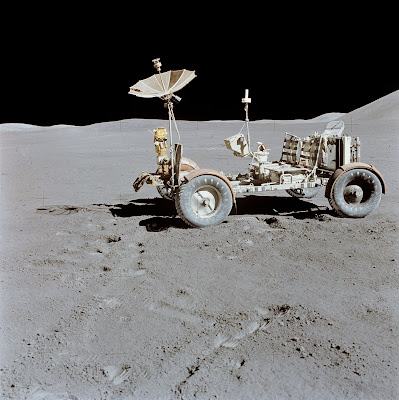 July 20, 1969 marked the day we landed on the moon. In celebration of the 40th anniversary, I decided to see how far we’ve come building electric-car technology by drawing extremely relevant comparisons of the Lunar Rover Vehicle (LRV) to the Tesla Roadster.
July 20, 1969 marked the day we landed on the moon. In celebration of the 40th anniversary, I decided to see how far we’ve come building electric-car technology by drawing extremely relevant comparisons of the Lunar Rover Vehicle (LRV) to the Tesla Roadster.
The contract to build the Apollo Lunar Rover went to Boeing with Delco as a major sub-contractor. It was originally for $19,000,000 and called for delivery of the first LRV by April 1, 1971, but cost overruns led to a final cost of $38,000,000. That’s over $200 million in today’s doll hairs. [Source: Wikipedia]
The cost to get Tesla off the ground began with an initial investment of $145 million. Overruns, due to unknown and unforeseen circumstances from a technology that was originally favored 100+ years ago (including by Dr. Porsche), set them back another $40 million in convertible debt financing in November 2008. So, we are roughly at the same cost as driving a car on the moon.
Let’s see what our $200 million got us, shall we?
Rover
2 seat roadster
10 ft. long
7.5 ft. wide
3.75 ft. high
210 kg
Motor – 4X (one at each wheel) 54amp DC series wound motor capable of 0.26 HP 1.9kW @ 10,000 rpm
Suspension – Double horizontal wishbone with upper and lower torsion bars and a damper unit between the chassis and upper wishbone
Range – 22.5 miles traveled during Apollo 17 mission
Production run – 4
Tesla
2 seat roadster
12.9 ft. long
6 ft wide
3.6 ft wide
1,238 kg
Motor – 375 volt AC induction air-cooled electric motor with variable frequency drive 248 HP, 185 kW @ 5000-8000 rpm
Suspension – Independent. Upper and lower unequal length wishbones. Co-axial coil spring/telescopic damper. Sway bar.
Range – stated at 244 miles
Production run – 500 to date
 An operational constraint on the use of the LRV was that the astronauts must be able to walk back to the lunar module if the LRV were to fail at any time during the trip. This was called the “Walkback Limit”. Huh, I didn’t see that coming but it makes complete sense for someone that needs oxygen to live.
An operational constraint on the use of the LRV was that the astronauts must be able to walk back to the lunar module if the LRV were to fail at any time during the trip. This was called the “Walkback Limit”. Huh, I didn’t see that coming but it makes complete sense for someone that needs oxygen to live.
We clearly must have over come these operational limits 40 years later with Tang on our tables and computers in our pockets…. haven’t we? Sadly no. The best we can come up with (according to the hype) is an electric car that begets a game of Tetherball. The faster you hit it, the quicker the game is over and you’ll never “have-a-ball” far from a pole.


Jim the Wizard
My dad has a picture of his parents in an electric car, in Detroit, in 1921. That electric carriage didn’t cost $200M to build. Like teatherball, the game starts at the pole.